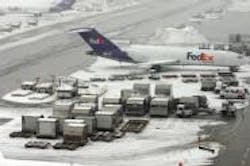“Trucking is not necessarily a competing type of transportation in many cases but a part of a transportation network that helps to make commerce work successfully where and when working together. One feeds into the other … the other sometimes being even water-borne delivery. This is a concept that only those integrally involved in the movement of freight really understand. I suspect that most people have never thought about it.” –Allan Berger
I trade some very enlightening emails with readers on a variety of subjects, and recently a real good one came from Allan Berger about how trucking really shouldn’t be viewed as a “stand-alone” mode of transportation anymore – and why it’s far more valuable when viewed as an “integrated” part of the supply chain
To illustrate his point, Berger told me about visits he made several years ago to major air cargo hubs such as Memphis, TN (home to FedEx), Louisville, KY (United Parcel Service’s base of air cargo operations) and the former Airborne Express’ central location in Wilmington, OH (an air hub that fell on hard times when DHL retrenched last year).
“There were slews of tractor trailers not owned by these three express carriers’ at all three sites that were dedicated to bring in freight by 2:00 a.m. and leaving with freight after 2:00 a.m.,” he recalled. “And 2:00 a.m. was a madhouse at all three places as planes started landing as if coming back from a massive bombing mission. But that's when I learned that UPS ‘red’ did not mean next day UPS Air, and the Fed Ex Next day did not mean it shipped on a Fed Ex plane, and that Airborne's equivalent service did not necessarily mean all of their freight would be shipped by air – all despite their names.”
This isn’t a criticism, Berger stressed. Rather, he pointed out that obligation of each express carrier is to deliver their freight – be they envelopes, packages, pouches, boxes, etc. – within the time frame that represents the service paid for.
“As to how the package arrives on time is left up to the carrier,” Berger noted to me. “If it makes more financial and logistical sense to use trucks for certain freight between and two cities – for example from Wilmington, OH to Columbus, OH, or from Wilmington, OH to New York City – then the freight might go by truck. If it’s longer distance, UPS might elect to [send it] truckload to, say, the West Coast; or put it on an intermodal train rather than use air or trucking.”
The point, he said, is that when shippers ask for overnight, next day, second day, next business day, etc., all they REALLY care about is that the package is delivered when it has been contracted to be delivered – however it happens.
“Carrier pigeons are okay if that works also,” Berger said. “That means trucking is not necessarily a competing type of transportation in many cases but a part of a transportation network that helps to make commerce work successfully where and when working together.”
That “working together” philosophy is partly behind the recent creation of the North American Council for Freight Efficiency (NACFE). Guided by the Rocky Mountain Institute, this council’s ultimate goal is to find ways to move the same amount of freight currently shipped in North America, but only use half the energy. It’s a tall order, no doubt – one that require a lot of rethinking where trucking is concerned.
[In that vein, Mike Ogburn, a vehicle consultant with RMI, talks about how even fundamental measurements of transportation energy efficiency – “fuel economy” parlance – can be difficult to gauge with accuracy.]
Another big conundrum is changing the public perception of trucking and the freight-carrying industry as a whole – because public perception is driving the political process in ways that can be detrimental to trucking’s efficiency; something that also significantly affects the environmental impact of trucking as well.
[John Woodroffe, head of the University of Michigan’s Transportation Research Institute (UMTRI) safety analysis division, talks about that impact below.]
Finally, it’s also important to recognize that trucking is a very complicated industry – something that often times gets overlooked in the oversimplified freight calculation of moving goods from point A to point B. With emission regulations making the cost of even the most basic of Class 8 tractors equal to that of a Ferrari in some cases, it’s important to recognize in a broad sense how that affects the overall cost of moving freight.
[Amory Lovins, chief scientist and chairman of the Rocky Mountain Institute, shares some thoughts on that subject line below.]
For these reasons, being an “integrator” within the supply chain could prove very beneficial to trucking in a lot of ways – as well as help the transportation chain maintain both efficiency and environmental goals at the same time. It’s a line of thinking worth exploring in days and months ahead.
